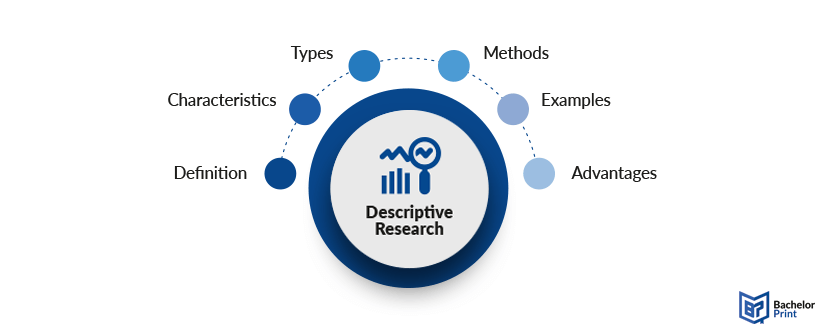
Unlike experimental research, which seeks to establish cause-and-effect relationships by manipulating variables, descriptive research aims to accurately describe and understand the characteristics of a subject without influencing it. This descriptive research methodology relies on observation, surveys, and case studies. It’s a crucial step in the scientific process, offering a detailed snapshot of the subject at a specific time and aiding in forming hypotheses and navigating future research.
Definition: Descriptive research
Descriptive research is a research design that is used to investigate different phenomena, groups, and processes, as they exist in a specific population or setting. This methodology does not manipulate the study variables or look for cause-and-effect relationships. Instead, descriptive research focuses on providing a snapshot of the current state of affairs, offering insights into the “what” aspect of the subject under study. Descriptive research is foundational in forming hypotheses, identifying patterns, and setting the stage for further experimental research or correlational research. Essentially, it serves as a cornerstone in the edifice of scientific enquiry, offering a critical lens through which researchers can capture the complexities of the real world. It also lays the groundwork for theory development and subsequent investigative research methodologies. Descriptive research has the following distinct key characteristics:
- Non-experimental: Observes subjects in their natural environment without manipulation.
- Quantitative and qualitative: Uses numerical data collection and qualitative observations.
- Cross-sectional or longitudinal: Conducted at a single point in time or over an extended period.

Descriptive research types
Descriptive research methods are designed to conduct data collection, analysis, and reporting systematically without attempting to influence the subjects under study. These methods are crucial for understanding the characteristics, behaviors, and overall phenomena of interest within their natural settings. The primary aim of descriptive research is to describe and interpret what exists at a given time. The following sections will outline the most commonly used types of methods in descriptive research. Each of them has its strengths and limitations, and the choice of study design and method often depends on the research question, objectives, and the practicalities of the research process and conduction.
Surveys and Questionnaires
Survey research and questionnaires are among the most widely used tools in descriptive research, offering a flexible and efficient means to collect data from a broad audience or specific population segments. These tools are instrumental in gathering quantitative information (numerical data) and qualitative insights (open-ended responses) about people’s behaviors, preferences, and experiences.
- They can cover a wide range of topics, e.g. employee satisfaction or social behaviors
- They can be administered in various formats, e.g. online platforms or phone interviews
- Allow researchers to collect data from a large number of respondents within a short timeframe
- It is crucial to craft clear, unbiased questions and determine whether to use open-ended or closed-ended questions for the research
- Conducting a pilot test with a small subset of the target population helps identify ambiguities or issues, ensuring reliability and validity
- Determining the sample size and sampling methods like simple random sampling, convenience sampling, and stratified sampling
- Quantitative analysis: Entails numerical data from closed-ended questions that are analysed using statistical methods
- Qualitative analysis: Entails responses to open-ended questions that are analysed to gather deeper insights into subjects
- Reporting: Findings are often presented in graphs, charts, and tables, which are interpreted in the context of the research objectives.
- Encouraging a high response rate is critical for the validity of the survey results. Strategies for this include ensuring anonymity, providing incentives, and simplifying the survey process.
- It is pivotal to be vigilant about potential research biases in question generating, response options, and the survey distribution process, as they might influence the accuracy of the findings.
Observational studies
Observational studies in descriptive research, involve watching, recording, and analysing behaviors and phenomena systematically, as they occur naturally, without any intervention. This type of observation of subjects is fundamental in fields where the alteration of variables could change the outcome or where intervention is not ethical or feasible. Observational studies allow collecting real-world data, thereby, offering insights into processes, behaviors, and outcomes in their natural context.
- Naturalistic observation: Observing subjects in their natural environment and most authentic form without any interference
- Participant observation: The researcher becomes part of the studied group, either overtly or covertly, providing first-hand insights
- Structured observation: Some variables within the setting are controlled to ensure specific behaviors can be observed.
- Capture authentic behaviors and phenomena, providing genuine insights
- Adaptable to various settings and subjects, providing flexibility
- Aid hypothesis generation and the direction of future experimental studies
- Observers’ perspective can influence interpretations, bringing across subjectivity
- Presence of researchers might alter the subjects’ behaviour ⇾ Hawthorne effect
- Privacy, consent, and ethical treatment of subjects are to be strictly considered
- Quantitative analysis: Entails, e.g., frequency counts of specific actions or behaviors
- Qualitative analysis: Entails, e.g., detailed notes on behaviors and interactions
- Reporting: Findings are often presented through coding behaviors observed during interactions
Case study method
Using the case study method in descriptive research allows for a deep investigative approach, focusing on exploring, understanding, and explaining complex issues within their real-life context. This method is distinguished by its intensive examination of a single case or a small number of cases, where a case makes out an individual, group, event, organisation , or community. Case studies are particularly valuable in descriptive research, as they provide insights into aspects of the subject that might be overlooked by other research methods.
- Comprehensive and in-depth exploration of the case in context
- Qualitative and quantitative data for multifaceted perspectives on the case
- Emphasis on the importance of context in understanding the case
- Focus often on unique, particularly informative, or representative cases
- Provide a level of detail that can reveal deep insights and complexities
- Can be used at any stage of the research process
- Inform the development of hypotheses for further research
- Findings are often not widely generalizable due to unique or specific nature
- Researchers’ perspectives can influence the study throughout the process
- Case studies are often labour-intensive and time-consuming
- Identifying the case(s) for the study
- Collecting data through various means
- Analyzing the data to identify insights
- Presenting and reporting the findings
Cross-sectional and longitudinal studies
The cross-sectional study design and the longitudinal study design are fundamental cornerstones in the descriptive research design for the subject under investigation. While both are instrumental in various fields of study such as human behaviour, health, psychology, and social sciences, they differ significantly in their approach, methodology, and the type of data they produce.
Cross-sectional studies
A descriptive cross-sectional study observes a specific population or phenomena at a single point in time. This “snapshot” approach aims to examine the prevalence and characteristics of a particular issue within a defined population. As one of its key characteristics in descriptive research, cross-sectional studies collect data simultaneously with the observation taking place. Moreover, they can be used to describe the frequency of characteristics or to explore associations between the study variables. As only a single point in time is observed, temporal trends can’t be evaluated. The following table outlines the advantages and limitations of a cross-sectional study used for descriptive research.
Examples
The following outlines several examples illustrating the diversity of the application of cross-sectional studies for descriptive research in the fields of public health, education, psychology, and economics.
A Representative study sample of adults is surveyed at a specific time to examine blood pressure levels, along with lifestyle factors such as exercise, smoking, and diet. This type of study helps identify the burden of hypertension in the community and associated risk factors.
Descriptive research with an observational study design, monitoring students in various classrooms one time and analysing how factors like teaching methods, classroom site, and available resources correlate with student interest and participation.
Descriptive research, surveying adolescents from different age groups about their social media habits and mental health indicators such as anxiety, happiness level, and stress. This type of study allows for the comparison of experiences of different age groups at once.
Data collection on household income and expenditure from a range of households at a specific time to evaluate how income impacts spending behaviour on services and goods.
| Pros | Cons |
|
|
Longitudinal studies
Longitudinal studies are across descriptive research types, one of the most prominent ones. They pose cornerstones characterized by their approach of following the same target subjects over a period of time to observe developments and changes. This descriptive research approach allows us to track patterns, potentially infer causal relationships, and understand the evolution of phenomena. In contrast to cross-sectional studies, longitudinal studies offer a dynamic view, charting transformations and trends across diverse intervals.
Examples
Longitudinal studies are integral for descriptive research and in understanding how study variables and phenomena change over time, uncovering patterns, effects, and causes that might not be grasped through other descriptive study designs. The subsequent section lays out examples of landmark longitudinal studies in several fields such as public health, education, behavioural science, and economics.
| Pros | Cons |
|
|
Advantages and disadvantages
Overall, descriptive research poses a powerful tool for capturing the essence of what exists or what Is occurring within a particular domain or population. It can provide an accurate and detailed picture, which is invaluable for grasping complex phenomena, laying the groundwork for subsequent studies, and informing policy and practice. However, it is crucial to carefully consider when descriptive research is appropriate to conduct.
It is relevant to use descriptive research, when…
- …there is little information about a case and the need to gather basic information for hypothesis generation.
- …tracking trends and patterns over time is required to understand how phenomena evolve and change.
- …businesses aim to understand consumer preferences, market trends, and behaviors to inform research.
- …the current state of educational practices, student performance, or teaching methodologies is needed.
- …social norms, behaviors, and cultural practices within a population at a given time need to be examined.
Understanding the advantages and disadvantages of descriptive research can help researchers make informed decisions about their study design.
| Pros | Cons |
|
|
in Your Thesis
FAQs
Here is a list of the types of descriptive research:
- Surveys and questionnaires
- Observational studies
- Case studies
- Longitudinal studies
- Cross-sectional studies
Qualitative descriptive research focuses on providing detailed descriptions of experiences, phenomena, or behaviors from the perspective of those experiencing them. It relies on non-numerical data like interviews, observation, and text analysis to capture and interpret the subject matter.
The descriptive research survey method employs surveys, questionnaires, or interviews to collect data on the current state of a population’s characteristics or opinions, providing a snapshot to identify trends and inform decisions.
Here are a few examples of descriptive research:
- Studying the learning styles of high school students to adjust teaching methods to the majority
- Surveying customer satisfaction levels with a new product to assess areas for improvement
- Observing children’s behaviour in a playground to understand interaction patterns among various ages
- Determining the prevalence of smoking within a specific demographic group
- Analyzing census data to describe trends in household composition and size over the last decade
Descriptive research studies aim to systematically describe a population, phenomenon, or behavioural pattern as it naturally occurs without manipulating or modifying the variables.
